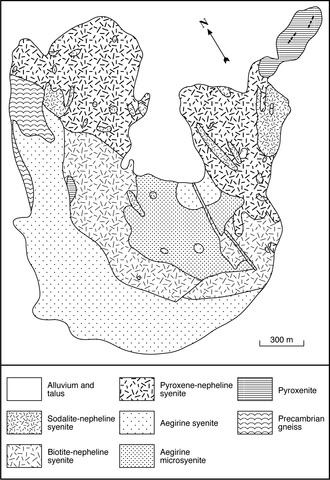stripes
Located in the extreme north of Malawi, and less than 3 km from the Nachendezwaya carbonatite in Tanzania (Tanzania, 41), Ilomba forms a horse-shoe-shaped hill some 3 km across rising about 335 m above the surrounding alluvium covered plain (Bloomfield et al., 1981; Ray, 1975). Contacts with the country rocks are not exposed, except on the northwestern side where Precambrian gneisses crop out, but Bloomfield (Bloomfield et al., 1981) describes these as grading into perthosites, which are one of the major rock types of the complex. Gneisses, surrounded by alluvium, also outcrop along a stream that flows within the horse-shoe. The perthosites and, in places, other rocks of the complex, show a foliation, which is distinguished from flow textures, and the perthosites may be part of the Songwe syenite complex (No. 103-00-001) and older than the feldspathoidal rocks of the complex. Within the complex no cross-cutting relationships have been observed. The central core of the intrusion consists of nepheline syenite which is surrounded by an incomplete ring of biotite- and pyroxene-nepheline syenite. Small areas of sodalite-nepheline syenite occur within the biotite-nepheline syenite. There are gradational boundaries between the various types of nepheline syenite, which are partly enclosed by an outer ring of coarse-grained aegirine syenite (Eby et al., 1998), which is equivalent to the perthosite of Bloomfield et al. (1981). The northern end of the eastern limb of the complex is a low knoll of clinopyroxenite the contact of which with adjacent feldspathoidal syenites is obscured by colluvium, but rounded xenoliths of pyroxenite occur in the nearby foyaite and are also found near the summit of Ilomba. The biotite-nepheline syenite is coarse-grained and consists of perthite, abundant nepheline, biotite, a little aegirine-augite and sodalite and accessories. The pyroxene-nepheline syenite is generally strongly foliated, owing to the alignment of pyroxene and, to a lesser extent, aligned perthite and nepheline prisms. Large microcline perthite plates are commonly surrounded and cut by swirling areas of fine-grained feldspar and the plentiful nepheline is generally crowded with tiny pyroxene crystals (Woolley et al., 1996) and blebs of feldspar; the pyroxene varies from aegirine-augite to aegirine, biotite is minor and sodic amphibole and occasional eudialyte occur. Aegirine-rich syenite is found as near vertical sheets near the summit of Ilomba Hill (the pyrochlore pyroxenite and aegirine pegmatite of Bloomfield et al., 1981) and consists of aegirine with a little alkali feldspar, abundant pyrochlore and titanite, and some apatite, zircon, calcite and amphibole; betafite, eudialyte and an unidentified rare earth mineral have been found (Eby et al., 1998). The pyroxenite, which Bloomfield et al. (1981) consider to have been intruded into the Songwe Syenite Complex, contains up to 90% diopside, up to 25% interstitial magnetite, tiny green spinels and patchy calcic amphibole. The pyroxenes of Ilomba have been described by Woolley et al. (1996) who demonstrated that they form two groups one of which is characterised by relatively high Al which, it was suggested, reflects metamorphism during the Mozambique orogenic event. Eight whole rock analyses are given by Bloomfield et al. (1981) and a further six analyses, including REE and a range of other trace elements, by Eby et al. (1998). Bloomfield et al. (1981) give two analyses of uraniferous pyrochlore and Woolley et al. (1992) have described niobian titanite and eudialyte from a nepheline syenite.
BLOOMFIELD, K. 1968. The pre-Karoo geology of Malawi. Memoir, Geological Survey of Malawi, 5: 1-166.BLOOMFIELD, K., DEANS, T. and WELLS, M.K. 1981. The Ilomba alkaline complex, northern Malawi and associated uranium-niobium mineralisation. Overseas Geology and Mineral Resources, 57: 1-21.EBY, G.N., WOOLLEY, A.R., DIN, V. and PLATT, G. 1998. Geochemistry and petrogenesis of nepheline syenites: Kasungu-Chipala, Ilomba, and Ulindi nepheline syenite intrusions, North Nyasa Alkaline Province, Malawi. Journal of Petrology, 39: 1405-24.RAY, G.E. 1974. The structural and metamorphic geology of northern Malawi. Journal of the Geological Society of London, 130: 427-40.RAY, G.E. 1975. The geology of the Chitipa-Karonga area. Bulletin, Geological Survey of Malawi, 42: 1-101.WOOLLEY, A.R., PLATT, R.G. and EBY, G.N. 1992. Niobian titanite and eudialyte from the Ilomba nepheline syenite complex, north Malawi. Mineralogical Magazine, 56: 428-30.WOOLLEY, A.R., PLATT, R.G. and EBY, G.N. 1996. Relatively aluminous alkali pyroxene in nepheline syenites from Malawi: mineralogical response to metamorphism in alkaline rocks. The Canadian Mineralogist, 34: 423-34.

